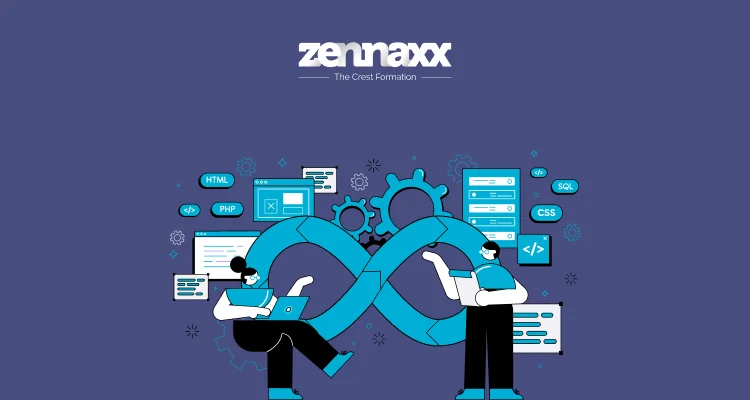Are you considering using DevOps methodology in your business software development? It could lead to more successful results.
So, many companies use DevOps methodology, but do you have questions about how it works? DevOps methodology comprises developers and IT operators.
DevOps is a cultural shift that bridges the gap between development and operations teams. It promotes seamless integration and automation throughout the software development lifecycle.
Enter DevOps, a paradigm that has transformed the way teams develop, deploy, and manage software systems.
This guide explores the DevOps methodology, focusing on its core principles, practices, benefits, and implementation strategies.
It’s suitable for IT professionals and newcomers, guiding them towards efficient, collaborative software delivery and achieving agility, reliability, and innovation.

What is DevOps Methodology?
DevOps is a software development methodology that supports the integration and collaboration of software development (Dev) and information technology operations (Ops) throughout the entire service lifecycle.
This approach spans from the initial design phase through the development process to ongoing production support and maintenance.
The overall goal is to create an environment that promotes seamless collaboration, transparency, and shared responsibility between these two traditionally distinct domains.
Because of DevOps, releasing new big projects and software has become easy and smooth for sectors. The combination of DevOps and agile development methods helps to develop and release projects from time to time.
Categorization and programming partitions facilitate development and implementation. With the time and best practices of the DevOps methodology, new functions and features can be added to projects quickly and efficiently.
How DevOps works: the DevOps life cycle

The DevOps life-cycle is often depicted as the continuous delivery pipeline when portrayed linearly. It includes a series of iterative and automated development processes. These are part of a more extensive, mechanical, and iterative development life-cycle.
The primary aim is to optimize the swift delivery of high-quality software. The following six workflows constitute the DevOps lifecycle:
1. Planning(Ideation)
2. Development
3. Integration (or Build, or CI/CD)
4. Deployment (Continuous Deployment)
5. Operations
Post-deployment activities ensure smooth feature operation in the production environment. We monitor feature performance, behaviour, and availability and address incidents promptly. We provide the overall health of the network, storage, platform, compute, and security.
6. Learning (Continuous Feedback)
Three additional continuous workflows interweave throughout these stages:
6.1 Continuous Testing
6.2 Security
6.3 Compliance
Address regulatory compliance from the planning stage throughout the development lifecycle. Ensure observability, traceability, and access in runtime operational environments. Auditability is crucial for compliance validation by third-party auditors.
The Goals of DevOps Methodology
1. Better Collaboration
2. Automation of Processes
3. Continuous Integration (CI)
Set up a continuous integration pipeline. This merges code changes from multiple members into a shared repository often. It also includes automated testing to find and deal with troubles early in the development cycle.
4. Continuous Delivery/Deployment (CD)
Achieve endless shipping by ensuring that code is always in a deployable category. For more advanced setups, enable non-stop deployment. This will robotically launch adjustments to manufacturing after passing a computerized evaluation.
5. Monitoring and Feedback Loops
Focus on non-stop monitoring of projects and testing. This provides real-time insights into performance and discovers capacity troubles directly. Implement comment loops to facilitate continuous development.
6. Infrastructure as Code (IaC)
Adopt machine-readable script files to manage coping with and provisioning infrastructure. This ensures consistency, repeatability, and efficiency in infrastructure automation.
7. Quick and Reliable Software Releases
Aim for more rapid improvement cycles. Make sure software program releases are brief, reliable, and meet people’s expectations for regular updates and characteristic upgrades. Do not compromise performance or availability.
The Major Benefits of Using DevOps
1. Fewer Silos and Improved Communication
2. Faster time to market
Accelerated software delivery, leading to a quicker time to market for applications and updates.
3. Rapid Improvement Based on Feedback
Continuous improvement is facilitated by prompt feedback loops, allowing for quick adjustments and enhancements.
4. Less Downtime
Reduction in downtime due to more reliable and consistent software releases.
5. Enhancement to the Software Delivery Pipeline
Optimization of the entire software delivery pipeline, including builds, validations, and deployment processes.
6. Automation Reduces Menial Work
Automation of repetitive tasks leads to a decrease in manual and menial work.
7. Streamlined Development Processes
Streamlined development processes by fostering increased responsibility and code ownership among development teams.
8. Broader roles and skills
Developing more comprehensive skill sets and roles allows team members to contribute to various aspects of the software development lifecycle.
Which Tools and Platform Right for DevOps
Typically, DevOps practitioners utilize a CI/CD pipeline, containers, and cloud hosting. The tools belong to categories like open-source, proprietary, or supported distributions of open-source technology.
They do this by maintaining version-controlled source code repositories. In a CI/CD pipeline, committed code changes in version-control repositories trigger subsequent steps. CI/CD pipeline engines automate the validation and delivery of applications throughout the development life cycle.
Configuration management tools like Puppet and Chef enable the provisioning and configuring of software, middleware, and infrastructure.
They use predefined scripts or templates. Cloud environments are often adopted concurrently with DevOps practices. They allow for automated deployment and scaling tasks.
Public cloud providers like AWS CodePipeline and Azure DevOps offer cloud-based deployment pipelines. They provide pre-integrated services for managing workloads. Additionally, the DevOps-as-a-Service model delivers a suite of tools.
The tools seamlessly cover the entire process of code creation, delivery, and maintenance. It fosters collaboration between software development and IT operations teams.
Skill Sets Required for DevOps Developers
DevOps developers, also known as DevOps engineers, must consistently implement and maintain DevOps practices with technologies. Here are some key skill sets required for DevOps developers:
1. Version Control Systems (VCS)
Understanding of distributed version control systems such as Git. Experience with branching, merging, and pulling requests.
2. Infrastructure as Code (IaC)
Proficiency in IaC best practices tools like Terraform, Ansible, or Puppet. Ability to define, manage, and version infrastructure configurations.
3. Containerization and orchestration
Familiarity with containerization technologies like Docker. Experience with container orchestration tools like Kubernetes, Docker Swarm, or OpenShift.
4. Cloud Platforms
Proficiency in cloud platforms like AWS, Azure, or Google Cloud Platform. Understanding of cloud services and resource provisioning.
5. Agile and DevOps Culture
Understanding of Agile development methodologies and the principles of the DevOps culture. Collaboration with development and operations teams is needed to achieve common goals.
DevOps developers are bridge-builders between development and operations teams. They are vast parts of the modern software development lifecycle. These are all the basic skills needed to make your career in DevOps development.
Want to Automate Your Business Process With a Software Solution?
Zennaxx, a leading software development firm in Canada, has delivered 700+ bespoke solutions spanning various industries.
What are the Challenges of Adopting DevOps?
One challenge you have to be clear in your mind before implementing this methodology is to help manage your project efficiently.
1. Organizational and IT changes, introducing new skills and job roles
Implementing DevOps often requires significant organizational and cultural changes. This includes breaking down silos between development and operations teams. It also involves fostering collaboration and promoting a culture of continuous improvement.
2. Implementation of expensive tools and platforms, with training and support
3. Proliferation of development and IT tools
The DevOps landscape has various tools (CI/CD, monitoring, orchestration, etc.). Managing and integrating many tools can lead to complexity and interoperability issues.
4. Caution regarding unnecessary, fragile, or unsafe automation
The push for automation is central to DevOps. However, it risks automating inefficient or unreliable processes, leading to unnecessary complexity and fragility.
5. Scaling DevOps practices across multiple projects and teams
What works well for a single team or project may take time to scale to the enterprise level. Coordinating DevOps practices across various teams and projects requires careful planning and coordination.
6. Increased deployment risks due to a fail-fast mentality and job generalization
The DevOps philosophy encourages a fail-fast mentality. If not managed properly, this can lead to increased deployment risks. Also, job generalization (e.g., developers performing operational tasks) may lead to skill gaps.
7. Emphasis on regulatory compliance, especially in role separation scenarios
Specific industries, like finance and healthcare, have strict regulatory requirements. These requirements mandate role separation and security controls. Implementing DevOps while adhering to these regulations requires careful planning.
8. Identification of new bottlenecks in processes
DevOps aims to streamline processes but can also reveal new bottlenecks as work moves faster through the pipeline. Identifying and addressing these bottlenecks is crucial for continuous improvement.
Organizations must prioritize collaboration, communication, and a commitment to continuous learning and improvement. This is how they can overcome these challenges.
Six Best Practices for DevOps Engineers for 2024
The DevOps methodology has completely changed how software products are developed in the IT industry.
Companies excel when their development and operations teams collaborate. They create exceptional and valuable products for users. Embracing the DevOps mindset is a worthwhile effort.
It can unlock your company’s true potential as long as it’s implemented effectively. Implement specific best practices across the entire project to fully benefit from DevOps. Foster a collaborative culture and use the right tools.
1. Foster a Collaborative Culture
Support cross-functional teams’ collaboration and shared responsibilities. Transforming to DevOps requires a cultural shift from top to bottom.
Focus on enabling people and fostering a culture of continuous learning and improvement. Use communication tools like HipChat, Slack, or Yammer to enhance collaboration.
2. Set Performance Metrics
Define objectives and performance metrics at the beginning of the DevOps process. Establish benchmarks related to the number of engineers and automated testing processes.
Involve project teams and stakeholders in goal-setting for a successful DevOps transformation. Metrics indicate the current state of DevOps efforts when communicating with upper-release management.
3. Have the Right DevOps Toolchain
Automation in DevOps and a well-chosen tool chain can significantly benefit your organization. Select tools that notify, track, and monitor performance metrics seamlessly. Prioritize processes over tools to avoid unnecessary complications.
4. Look for Long-Term Goals
Understand that DevOps is a long-term solution, not a quick fix. Avoid setting unrealistic goals; focus on securing acceptance from key organizational stakeholders. Recognize that complex transformations require time, resources, and careful planning.
5. Implement Automated Dashboards
Automated dashboards are invaluable for developers. They provide a holistic view of the software development life cycle. Dashboards offer insights, reports, and real-time monitoring of operations. Identify challenges and bottlenecks early in the process through automated dashboards.
6. Prioritize Security Practices
Security threats are rising. Prioritize security monitoring and assurance in your DevOps practices. Implement automated security controls without compromising agility.
Use proven version control best practices for scripts, software, templates, and blueprints. Ensure restricted access to source code and avoid including credentials in test and build scripts.
Implementing these best practices will help your organization’s DevOps transformation succeed. They will also make it more effective.
How to Adopt DevOps in Development
Begin by grasping the fundamental principles of DevOps. They emphasize collaboration, continuous delivery and automation in DevOps. Encourage shared responsibility between the development and operations teams.
Start small by implementing DevOps practices in a specific project or team. Choose the right tools that align with your organization’s needs.
These include version control systems, CI/CD tools, configuration management, and monitoring solutions. Prioritize automation to streamline repetitive tasks like code builds, testing, and deployments.
Implement continuous integration (CI) practices to integrate code changes frequently and receive quick feedback. Move towards continuous delivery (CD) to automate the deployment process. This makes releases faster and more reliable.
Consider using infrastructure as code (IaC) to manage and provision infrastructure automation. Establish robust monitoring practices to gain insights into system performance and health. Encourage a culture of continuous improvement.
Regularly assess and refine DevOps processes. Base changes on feedback and performance metrics.
Conclusion
DevOps methodology in your software development can lead to more successful results. DevOps is a collaborative process that aligns software development and IT operations. It focuses on iterative development, automation, and adaptable infrastructure deployment.
Why is it best for development? This method increases time management. It also creates more revenue because of its high success rate among companies.
Zennaxx Software Development Company is the right choice for your valuable project development. If your goal is to develop a high-quality project with extreme release management and support.
Contact us for a consultation; our team of experts will work closely with you to understand your needs. Together, we promise a solution that maximizes efficiency and productivity.


